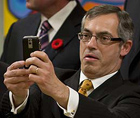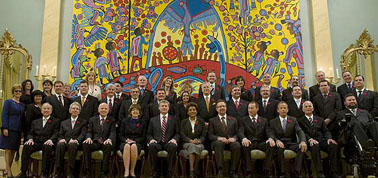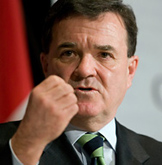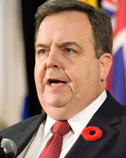Monday, 03 November 2008
 It’s hard to keep your mind focused on just what Stephen Harper’s new cabinet in Ottawa may mean, with the biggest US general election in your lifetime just a day away. As the Calgary Herald reported this morning, in Canada’s current most economically prosperous province, even up here the duel in the sun between Senators Obama and McCain has "created far more buzz than last month's competition between Tory Leader Stephen Harper and Grit boss Stephane Dion." It is of course nonetheless important to keep trying to pay attention to such subjects as Stephen Harper’s new cabinet. For one thing, Mr. Harper himself continues to bear watching, in case he actually does have a hidden agenda, etc. Then there is the perhaps related question of whether Prime Minister Harper is ultimately going to confirm the late George Grant’s mid-1960s prediction that the "impossibility of conservatism in our modern era is the impossibility of Canada" — in various new high-technological senses of which neither Mr. Grant nor Mr. Harper would likely approve. And then, finally, just what is going on anyway, when the former most economically prosperous (and still by far most populous) province winds up taking federal-provincial equalization payments (usually reserved for allegedly "have not" provinces)? Is this really how to "protect Canada’s future in a time of global economic instability?" It’s hard to keep your mind focused on just what Stephen Harper’s new cabinet in Ottawa may mean, with the biggest US general election in your lifetime just a day away. As the Calgary Herald reported this morning, in Canada’s current most economically prosperous province, even up here the duel in the sun between Senators Obama and McCain has "created far more buzz than last month's competition between Tory Leader Stephen Harper and Grit boss Stephane Dion." It is of course nonetheless important to keep trying to pay attention to such subjects as Stephen Harper’s new cabinet. For one thing, Mr. Harper himself continues to bear watching, in case he actually does have a hidden agenda, etc. Then there is the perhaps related question of whether Prime Minister Harper is ultimately going to confirm the late George Grant’s mid-1960s prediction that the "impossibility of conservatism in our modern era is the impossibility of Canada" — in various new high-technological senses of which neither Mr. Grant nor Mr. Harper would likely approve. And then, finally, just what is going on anyway, when the former most economically prosperous (and still by far most populous) province winds up taking federal-provincial equalization payments (usually reserved for allegedly "have not" provinces)? Is this really how to "protect Canada’s future in a time of global economic instability?"
Canadian cabinet-making traditions ...
 According to at least one tradition, federal cabinet-making in Canada is the single greatest test of any prime minister’s governmental skill and public philosophy. Cabinet-making, for instance, is the most important practical way in which Canadian federal governments accommodate the stubborn regionalism of the confederation — which starts in Quebec but then spreads vigorously east and west and only ends with any certainty at the north pole. According to at least one tradition, federal cabinet-making in Canada is the single greatest test of any prime minister’s governmental skill and public philosophy. Cabinet-making, for instance, is the most important practical way in which Canadian federal governments accommodate the stubborn regionalism of the confederation — which starts in Quebec but then spreads vigorously east and west and only ends with any certainty at the north pole.
Some say that this doesn’t mean much in Stephen Harper’s current case, since he largely runs his governments all by himself, and has his centralized Prime Minister’s Office keep all cabinet ministers on very tight leashes. Others, however, are now also suggesting that the new cabinet, appointed in the wake of Mr. Harper’s second Conservative minority government, elected just this past October 14, hints at some potential departures from this centralizing model of prime ministerial dictatorship and/or authoritarianism (or however else you might like to put it).
Before pondering this prospect, it is worth noting that the centralizing model — and all its attendant other political pathologies — has its own venerable traditions in the Canadian context. A rather long but still quite instructive (and entertaining) quotation from a famous enough Harold Innis essay of the late 1940s ("Great Britain, the United States and Canada") is a case in point:
Complexity compels the press to emphasize nonsensical subjects or to retreat to issues of the utmost simplicity. The hypothesis may be suggested that the tendency has also made for mediocrity in political leadership. It would be interesting to learn whether calculated stupidity has become a great political asset ... Perhaps political talent is inadequate to the demands of a large number of parties ... Cabinet-making becomes ‘a thoroughly unpleasant and discreditable business in which merit is disregarded, loyal service is without value, influence is the most important factor, and geography and religion are important secondary considerations.’ Sir John A. Macdonald regarded the ideal cabinet as one over which he held incriminating documents such as might place each member in the penitentiary. Broderick referred to the ‘malicious credulity of Canadian party spirit and the extreme lengths to which party warfare is carried at the instigation of a most virulent and unscrupulous press.’
Leona Aglukkaq: the aboriginal peoples of Canada in the federal cabinet
 Measured against this kind of harsh critique from 60 years ago (while also allowing for political satire, in the manner of one of Innis’s masters, Thorstein Veblen), Stephen Harper’s Canadian cabinet-making performance in the fall of 2008 could almost be judged to have at least one or two high-minded surfaces. The clearest case in point here would be the appointment of Leona Aglukkaq from the Nunavut territory as Minister of Health. Measured against this kind of harsh critique from 60 years ago (while also allowing for political satire, in the manner of one of Innis’s masters, Thorstein Veblen), Stephen Harper’s Canadian cabinet-making performance in the fall of 2008 could almost be judged to have at least one or two high-minded surfaces. The clearest case in point here would be the appointment of Leona Aglukkaq from the Nunavut territory as Minister of Health.
Just to start with, it is remarkable — and impressive enough, partisans of the Liberals and New Democrats ought to allow in any fairness — that a member of Mr. Harper’s new Conservative Party of Canada actually won Nunavut’s one seat in the Canadian House of Commons. From, here, and especially in a year that might very well see the election of the first African American president of the USA today, it is in the ancient traditions of the Liberal Party of Canada, that used to be the natural governing party of the diverse confederation, to appoint Ms. Aglukkaq to the cabinet. And the fact that Mr. Harper has made the appointment suggests something about him and his second-term minority government that could conceivably be impressive enough too.
Considering Ms. Aglukkaq’s inevitably limited experience in Ottawa, some critics might say that her appointment more fundamentally reflects how comparatively unimportant Mr. Harper thinks the federal Health portfolio is. And it is true enough that publicly funded health care in Canada is a primarily provincial not federal responsibility.
At the same time, Leona Aglukkaq "has served in numerous roles in the governments of both the Northwest Territories and Nunavut including that of Deputy Clerk of the Legislative Assembly and Deputy Minister for Culture, Language, Elders and Youth. She has served on the Arctic College Board of Governors, the Nunavut Impact Review Board and the Northwest Territories Science Institute." Aboriginal health is one area where Ottawa has more direct responsibilities. And if Ms. Aglukkaq somehow manages to improve this side of her new portfolio, her appointment could prove a practical as well as a symbolic success.
Other interesting appointments ...
 Probably the other most interesting of Stephen Harper’s new cabinet appointments is Jim Prentice as Minister of the Environment. Mr. Prentice may be the most impressively competent player on the Harper team, next to Mr. Harper himself (and now that the former Liberal cabinet minister David Emerson, who crossed the floor to the new minority governing Conservatives after the 2006 election, did not chose to run in the 2008 election). Probably the other most interesting of Stephen Harper’s new cabinet appointments is Jim Prentice as Minister of the Environment. Mr. Prentice may be the most impressively competent player on the Harper team, next to Mr. Harper himself (and now that the former Liberal cabinet minister David Emerson, who crossed the floor to the new minority governing Conservatives after the 2006 election, did not chose to run in the 2008 election).
Jim Prentice "was elected to the House of Commons in 2004 [for the Alberta riding of Calgary Centre-North] and re-elected in 2006 and 2008. He was named Minister of Indian Affairs and Northern Development and Federal Interlocutor for Métis and Non-Status Indians in February 2006 and Minister of Industry in August 2007."
His current move to Minister of the Environment seems to signal the Harper government’s intention to treat this portfolio with some kind of fresh urgency. And some early remarks by Mr. Prentice himself stiffen this impression:
"Speaking to reporters after the swearing-in ceremony, Prentice described the environment portfolio as an economic one and said it's a job that requires balancing the protection of both the environment and economy ... ‘Those responsibilities dealing with the important issues of energy security, the environment and the economy are, I think, some of the most challenging issues that we face,’ said Prentice. ‘Those are issues actually that are rendered more difficult by the economic slowdown rather than easier so those are the issues we'll be wrestling with.’"
More generally, the new "38-member cabinet is expanded from the former 32 members ... Harper did not drop any ministers from his previous cabinet and he brought in five newly elected MPs. As another vague sign of one kind of vague progress, the "appointments of Leona Aglukkaq to the health portfolio, Lisa Raitt to natural resources, and PEI.'s Gail Shea to fisheries boosts the number of women in the Conservative cabinet to 11 from seven ... More women voted for the Conservatives in this month's federal election and Harper seemed prepared to reward them with more seats at the cabinet table."
The somewhat larger cabinet will inevitably cost taxpayers somewhat more as well. This can be seen as something of an irony for the kind of conservative government that often figures in Mr. Harper’s rhetoric. And the point has been underlined even by Le Devoir in Quebec: "Le nouveau Conseil des ministres de Stephen Harper pourrait coûter 3,9 millions de plus aux contribuables en salaires seulement pour les ministres supplémentaires et leur personnel ... Le coût total du personnel attaché aux ministres, environ 24,2 millions en salaires, a augmenté de 19 % avec le remaniement ministériel de la semaine dernière, et de 42 % depuis que les conservateurs ont présenté leur premier cabinet, en 2006."
A few other more or less notable appointments (good and/or bad, according to your more exact taste): Stockwell Day as Minister of International Trade and Minister for the Asia-Pacific Gateway ; Lawrence Cannon as Minister of Foreign Affairs ; Tony Clement as Minister of Industry ; Jay Hill as Leader of the Government in the House of Commons ; Peter Van Loan as Minister of Public Safety ; Jason Kenney as Minister of Citizenship, Immigration and Multiculturalism ; Diane Ablonczy as Minister of State (Small Business and Tourism — why this reputedly quite talented lady doesn’t do better than this is a question many ask: it must be that she and Mr. Harper don’t altogether get along?) ; and Peter Kent as Minister of State of Foreign Affairs (Americas — a reward for a journalist who broke some fresh ground by finally getting elected in Thornhill, just north of the present City of Toronto!)
For the rest of the new ruling class in Ottawa, check out the official listing on Prime Minister Harper’s official website. There do appear to be some fresh gestures in all this, arguably intended to show that Stephen Harper is nowadays more concerned about fitting in with established traditions in the capital city of the 1867 confederation, than he is with trying to force these traditions to fit the more radical right-wing ideological enthusiasms of his youth. Whether this apparent concern is more than a clever illusion no doubt remains to be seen. And of course it still does remain true that, when push finally does come to shove, Mr. Harper still does have a mere minority government, even if it is stronger than it was before.
What is really happening in old Ontariario ... ?
 The Honourable James Michael Flaherty — former Ontario finance minister under the Common Sense Revolutionary regime of mean and nasty Mike Harris — has remained Mr. Harper’s current federal Minister of Finance as well. And today (November 3, 2008) he "announced ... that Ontario will join the ranks of the ‘have-not’ provinces next year, paving the way for it to receive payments under the national equalization program for the first time." The Honourable James Michael Flaherty — former Ontario finance minister under the Common Sense Revolutionary regime of mean and nasty Mike Harris — has remained Mr. Harper’s current federal Minister of Finance as well. And today (November 3, 2008) he "announced ... that Ontario will join the ranks of the ‘have-not’ provinces next year, paving the way for it to receive payments under the national equalization program for the first time."
What Harold Innis described some 60 years ago as the "most virulent and unscrupulous" Canadian mass media’s tendency to "emphasize nonsensical subjects or to retreat to issues of the utmost simplicity," in the face of the increasing complexity of modern life, has prompted much media moaning and hand-wringing over all this, at least in Ontario itself.
Ontario finance minister Dwight Duncan, however, finally did manage to explain to Mike Duffy on CTV something at least fairly close to the truth of what is happening. As a recent TD Bank study has explained, Canada’s most populous province is still sending $11.5 billion more to Ottawa each year than it gets back in federal government services and capital spending. Now, for the 2009-2010 fiscal year, it will be receiving a $347 million federal equalization payment, to help make up a small part of the difference.
In fact, Ontario has technically qualified for such modest federal equalization payments in the past, but has never actually taken the money. And the times when this has happened have been other times when, e.g., oil and gas revenues in Alberta especially have dramatically outstripped revenues in other parts of the country, including the once industrially prosperous Ontario.
 Resource revenues of this sort go down as well as up. And Dwight Duncan believes that "Ontario's ‘have-not’ status will be a ‘short-term phenomenon.’" This has in fact happened in the past, when Ontario did not bother to take the short-term equalization money for which it technically qualified. (This time of course there is the current great economic slowdown as well, though something at least slightly similar was also afoot in the late 1970s and early 1980s.) Resource revenues of this sort go down as well as up. And Dwight Duncan believes that "Ontario's ‘have-not’ status will be a ‘short-term phenomenon.’" This has in fact happened in the past, when Ontario did not bother to take the short-term equalization money for which it technically qualified. (This time of course there is the current great economic slowdown as well, though something at least slightly similar was also afoot in the late 1970s and early 1980s.)
There is, it seems, another concern about the future of dramatically rising oil and gas revenues in Alberta — tied to the potential results and consequences of the November 4 US election: "Although a boon to government coffers and the national economy, extracting sticky, tar-like bitumen from the ground and upgrading it into usable oil takes a large toll on the environment. Oilsands development produces three times more greenhouse gases than a conventional barrel of oil, leading several Canadian and American environmental groups to label Alberta's bitumen bonanza ‘dirty oil.’ ... Whether this label sticks with Washington policy-makers may become apparent after Tuesday's US election ... Ron Stevens, Alberta's minister of international and intergovernmental relations, expects changes are looming to American environmental policies, which could impact the province's energy industry." At some point soon enough, that is to say, Canada’s current federal-povincial equalization system could change yet again. Only registered users can write comments.
Please login or register. Powered by AkoComment 1.0 beta 2!
|
